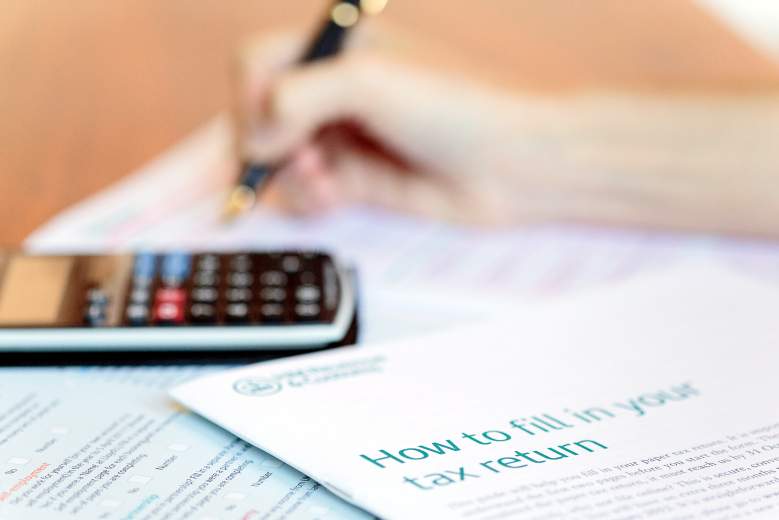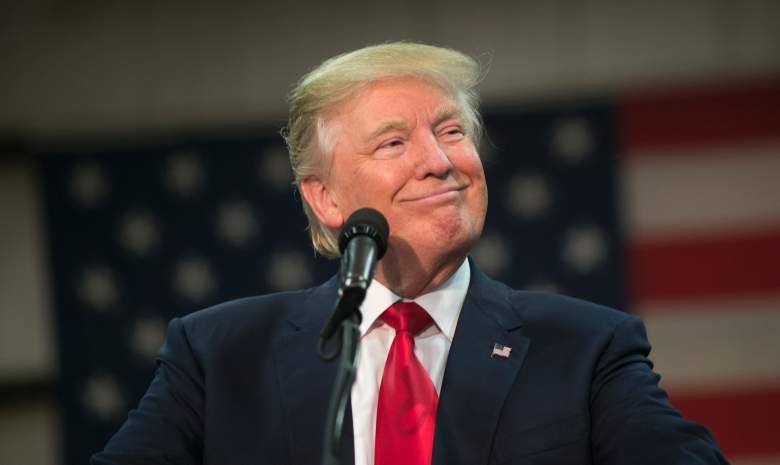
Income tax rates will go down for most Americans under Trump’s plan. (Getty)
Any time a new president is about to enter the White House, millions of Americans become concerned about their taxes going up in the near future. So what is President-Elect Donald Trump’s tax plan? Will your taxes be raised or lowered once he makes the changes he has promised?
Trump released a detailed tax plan back in September, which is quite different from the one he originally proposed in 2015. Although it’s not guaranteed that every bit of this proposal will make it into the final legislation, Trump has a lot of room to accomplish his goals with Republicans holding majorities in both houses of Congress.
Under Trump, payroll taxes will remain exactly the same. However, most Americans will see a reduction in income taxes, while for some their rate will stay the same and for some it will be raised slightly. Several taxes will be removed, including the 3.8 percent Obamacare tax on the wealthy. Trump plans to encourage taxpayers not to file itemized deductions; he will do this by dramatically increasing the standard deduction and encouraging Americans to take this instead. There will also no longer be any personal exemptions.
Here’s what you need to know about Donald Trump’s proposed tax plan and how it will affect you if it goes into law next year.
1. Reduced Tax Brackets

Donald Trump speaks to supporters in Warren, Michigan. (Getty)
A key aspect of Donald Trump’s tax reform proposal is reducing the number of income tax brackets from seven to three. Congressional Republicans are in agreement on this, with this tax bracket plan also being present in Paul Ryan’s A Better Way. Republicans would like to make it simpler for individuals to file their taxes, and they would also like to lower taxes on the wealthy.
At the moment, there are seven income tax brackets. They are:
| Single Filer | Joint Filer | Head of Household Filer | Rate |
| $0 – $9,275 | $0 – $18,550 | $0 – $13,250 | 10% |
| $9,275 – $37,650 | $18,550 – $75,300 | $13,250 – $50,400 | 15% |
| $37,650 – $91,150 | $75,300 – $151,900 | $50,400 – $130,150 | 25% |
| $91,150 – $190,150 | $151,900 – $231,450 | $130,150 – $210,800 | 28% |
| $190,150 – $413,350 | $231,450 – $413,350 | $210,800 – $413,350 | 33% |
| $413,350 – $415,050 | $413,350 – $466,950 | $413,350 – $441,000 | 35% |
| $415,050 + | $466,950 + | $441,000 + | 39.6% |
Donald Trump’s plan, if enacted, will remove the Head of Household filing status entirely, and it will reduce the number of tax brackets down to three. The new tax brackets would be:
| Single Filer | Joint Filer | Rate |
| $0 – $37,500 | $0 – $75,000 | 12% |
| $37,501 – $112,500 | $75,001 – $225,000 | 25% |
| $112,501 + | $225,001 + | 33% |
Under Trump’s plan, for single filers, income between $0 and $9,000 is taxed at a rate of 12 percent, up from 10 percent today. However, income between $9,000 and $37,000 is also taxed at a rate of 12 percent, down from 15 percent today. Income between $37,000 and $90,000 will be taxed at a rate of 25 percent, the same rate as in the current tax code. Next, income between $90,000 and $112,000 will be taxed at a rate of 25 percent, down from 28 percent today.
The only increase comes on income from $112,000 to $190,000; this income will be taxed at a rate of 33 percent, an increase from 28 percent today. From $190,000 to $413,000, there will be no change, with the rate being kept at 33 percent as it is right now. The biggest reductions go to those at the top, as income between $413,000 and $415,000 will be taxed at 33 percent, down from 35 percent. And income above $415,000 is taxed at 33 percent as well, down from 39.6 percent today.
Capital gains and dividends will also no longer be taxed at preferential rates. Instead, for those in the first income tax bracket, the capital gains rate will be 0 percent; for those in the second bracket, it will be 15 percent; and for those in the third bracket, it will be 20 percent.
As well, Trump’s plan involves eliminating the Net Investment Tax, a 3.8 percent Obamacare tax that applies to high-earners (over $200,000 for an individual and over $415,000 for joint filers). He also will repeal the Alternative Minimum Tax.
2. Increases in the Standard Deduction

Trump also referred to the FBI renewing its investigation into the Clinton emails. “Did you hear about this little event?” he asked the crowd. (Getty)
Under Trump’s plan, the standard deduction will be increased. This is the flat amount of money that tax filers can deduct from their return each year rather than taking itemized deductions.
This is how the standard deduction system is currently set up:
| Filing Status | Standard Deduction |
| Single | $6,300 |
| Joint | $12,600 |
| Head of Household | $9,300 |
| Personal Exemption | $4,050 |
Trump will substantially raise the standard deduction for single and joint filers but eliminate the head of household filing status. The new standard deductions will be:
| Filing Status | Standard Deduction |
| Single | $15,000 |
| Joint | $30,000 |
As part of a plan to simplify the tax-filing process, Trump hopes more people will take the standard deduction rather than utilizing itemized deductions. Trump will also cap itemized deductions at $200,000 for joint filers and $100,000 for single filers.
3. Elimination of Personal Exemptions

Donald Trump speaks in Tallahassee, Florida. (Getty)
Trump also plans to completely eliminate personal exemptions, the deduction you receive for each child or dependent on your tax return. This is his trade-off for making the standard deduction so high.
As an example of how this might affect the average household, under current tax law, a married couple with two children would receive a standard joint deduction of $12,600, plus $16,200 in personal exemptions, according to Forbes. This adds up $28,000 in deductions. Under Trump’s law, the family no longer gets those personal exemptions, but that’s offset by the fact that their standard deduction goes up to $30,000. Therefore, they actually gain $2,000 in deductions under Trump.
For a married couple with three children, however, they would currently receive the $12,600 standard deduction and $20,250 in personal exemptions; this adds up to $32,850. Under Trump’s proposal, their deduction would go down to $30,000, $2,850 less than it would be this year.
Trump plans to make up for this this with his childcare tax breaks.
4. Child Care Tax Breaks

Donald Trump campaigning in Ohio where he and Clinton are running neck-and-neck in polls. (Getty)
Under Trump’s proposal, parents can take an above-the-line tax deduction if they are raising a child under the age of 13, with that deduction being capped at the state’s average cost of child care for any given age. The national average cost of childcare per year is $12,000, according to Forbes. This tax break does not apply to individuals earning more than $250,000 or couples earning more than $500,000, and it is limited to four children per taxpayer.
The tax break also applies to the elderly, with tax filers being able to deduct the state’s average cost of eldercare for a dependent. This eldercare deduction is capped at $5,000 a year.
For low-income families, Trump’s plan offers a tax credit of up to $1,200. This will be available to individuals making less than $31,000 a year or joint filers making less than $62,000 a year.
There will also be the creation of new child care savings accounts, with taxpayers being able to contribute up to $2,000 into this account per year. The government will provide a 50 percent match on contributions up to $1,000 a year for low-income families.
5. Lowered Business Tax Rates, Elimination of the Estate Tax

Donald Trump speaks at a rally in Grand Junction, Colorado. (Getty)
Trump’s plan will be extremely beneficial to business owners. The business tax rate is currently 35 percent, but under Trump, it will be lowered to 15 percent. This applies to all businesses regardless of size.
In addition, Trump hopes to eliminate a number of tax loopholes. One of these is the carried interest loophole; Trump will now tax this at the same rate as ordinary income (Hillary Clinton also proposed this). Plus, he aims to eliminate the corporate alternative minimum tax.
Trump intends to completely eliminate the estate tax as well. Right now, individuals can leave up to $5.5 million to an heir without paying any additional taxes on that money. Anything above $5.5 million, however, is taxed at 40 percent. This only really applies to the very rich, but Trump’s plan will remove that 40 percent tax. Instead, inherited assets valuing over $10 million will be taxed, but only when those assets are sold, according to UBS Advanced Planning.